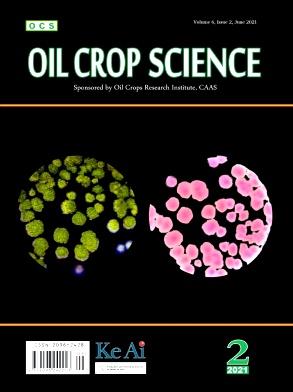Genetic relationship between bacterial wilt resistance and yield components in peanut
Q3 Agricultural and Biological Sciences
引用次数: 0
Abstract
Bacterial wilt (BW) caused by Ralstonia solanacearum is a wide-spread and serious disease in peanut. To date, this soilborne disease could only be effectively controlled by planting resistant peanut cultivars. However, the relatively lower yield potential of the available BW-resistant peanut cultivars is a key reason restricting productivity in most epidemic regions naturally infested with the pathogen. Even small pods or seeds and low number per plant has been regarded as the key factor for the low yield potential both in BW-resistant peanut germplasm lines and available released cultivars, whether the resistance is closely linked with key yield components remains unclear. In this study, the relationship between pod weight and BW resistance was analyzed by using a recombinant inbred lines (RIL) population derived from a crossing combination between a high yielding cultivar Xuhua 13 and a BW-resistant cultivar Zhonghua 6. From the experiments, it was found that the BW resistance was not significantly correlated with pod number per plant (PNP), hundred pod weight (HPW) and pod weight per plant (PWP) in the RIL population. Based on linkage analysis, the quantitative trait locus (QTL)s related to PNP were identified on A06, A07, A08 and B03. The QTLs for HPW were detected on A05 and A07, and the QTLs for PWP were on A06, A07 and B03. However, the QTL for BW resistance identified on B02. These results indicated that the BW resistance and the pod number per plant as well as pod weight were inherited independently. Two recombined lines (QT0944 and QT1028) with high level BW resistance and large pods (hundred pod weight over 185g) were identified from the RILs, and they possessed the favored alleles of identified QTLs from both parents, which could be used in peanut breeding for high yield and high level disease resistance.
花生细菌性枯萎病抗性与产量成分之间的遗传关系
青枯病(Bacterial wilt, BW)是一种广泛流行且危害严重的花生病害。迄今为止,这种土传疾病只能通过种植抗性花生品种来有效控制。然而,现有抗虫病花生品种的产量潜力相对较低,是制约大多数病区生产的关键原因。在抗虫病花生种质系和现有品种中,即使荚果或种子小、单株数量少也被认为是造成产量潜力低的关键因素,但这种抗性是否与关键产量成分密切相关尚不清楚。本研究以高产品种旭华13号与抗病品种中华6号杂交组合的重组自交系(RIL)群体为材料,分析了荚果重与抗体重的关系。结果表明,RIL群体对BW的抗性与单株荚果数(PNP)、百粒重(HPW)和单株荚果重(PWP)无显著相关。通过连锁分析,分别在A06、A07、A08和B03上鉴定出与PNP相关的QTL。在A05和A07上检测到HPW的qtl,在A06、A07和B03上检测到PWP的qtl。然而,B02上鉴定出了BW抗性QTL。结果表明,抗体重、单株荚果数和荚果重是独立遗传的。从rls中鉴定出2个高抗BW和大荚果(百粒重大于185g)的重组品系QT0944和QT1028,它们具有亲本qtl的有利等位基因,可用于花生高产、高抗病育种。
本文章由计算机程序翻译,如有差异,请以英文原文为准。
求助全文
约1分钟内获得全文
求助全文
来源期刊

Oil Crop Science
Food Science, Plant Science, Agronomy and Crop Science
CiteScore
3.40
自引率
0.00%
发文量
20
审稿时长
74 days
 求助内容:
求助内容: 应助结果提醒方式:
应助结果提醒方式:


